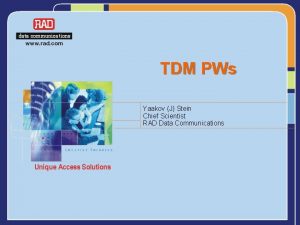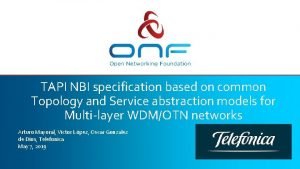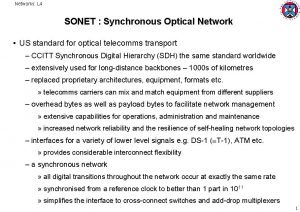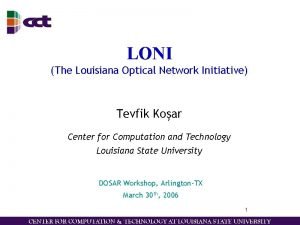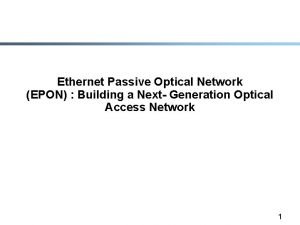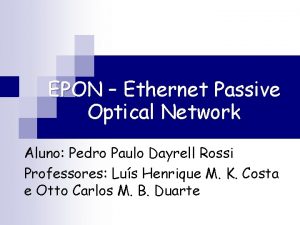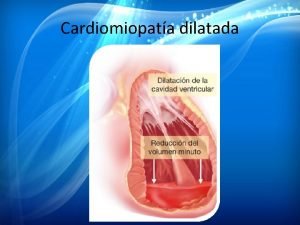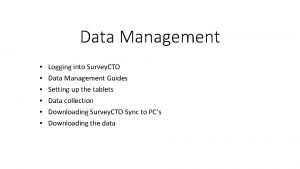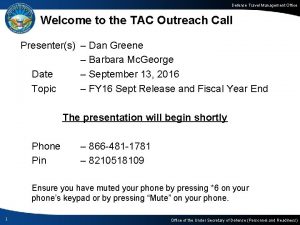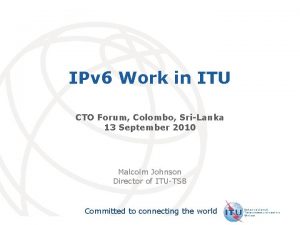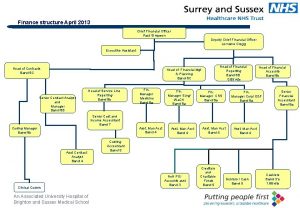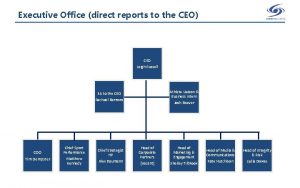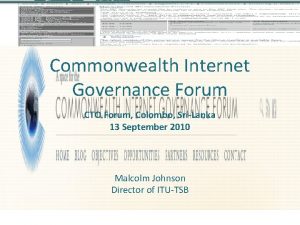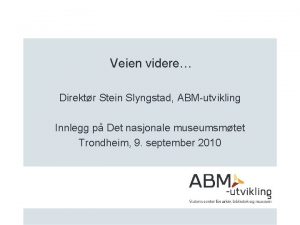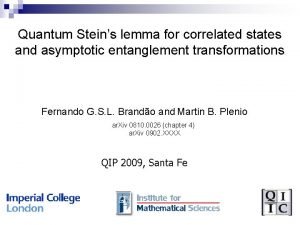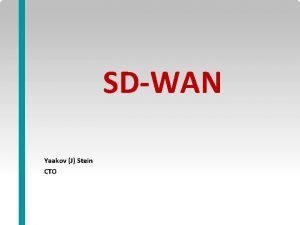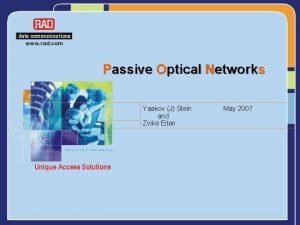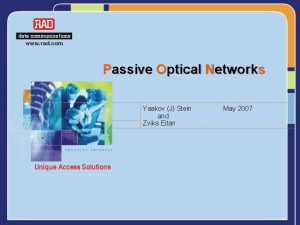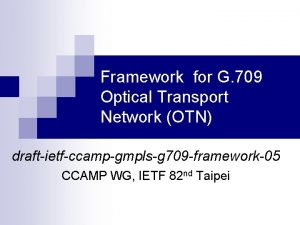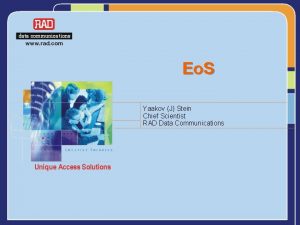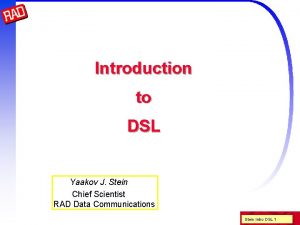Optical Transport Network OTN Yaakov Stein CTO OTN



















































- Slides: 51

Optical Transport Network OTN Yaakov Stein CTO

OTN In the beginning there was the DS 0 a 64 kbps serial bit stream Multiple (24 or 32) DS 0 s could be synchronously combined to form TDM – T 1 or E 1 at up to 2 Mbps Multiple TDM streams could be combined plesiochronously to form PDH with rates up to 45 Mbps (defined up to T 4 at 275 Mbps) Multiple PDH streams could be synchronously combined to form SDH (SONET) with rates up to 10 Gbps (defined up to STM 256 at 40 Gbps) For higher rates over fiber Optical Transport Network technology was developed and it can transport SDH and Ethernet signals with rates from 2. 66 G to 420 G (and higher rates too!) Y(J)S OTN 2

This is only a short introduction OTN is a rich ecosystem, and can not be fully covered in this short introduction We will concentrate on : • OTN equipment types • capabilities • traditional rates and frame formats We will only mention : • GMPLS management • physical layer optics • synchronization aspects • newer rates and features Y(J)S OTN 3

Where to look for more information? G. 709. 1 G. 709. 2 G. 709. 3 G. 709. 4 G. 7041 G. 872 G. 873. 1 G. 873. 2 G. 873. 3 G. 874 G. 875 G. 959. 1 G. 975 G. 7044 G. 7702 G. 8251 v 2 v 3 Interfaces for the optical transport network (note that there are 2001, 2003, 2009, 2012, 2016, 2020 editions) Flexible OTN short-reach interfaces OTU 4 long-reach interface Flexible OTN long-reach interfaces OTU 25 and OTU 50 short-reach interfaces Generic framing procedure Architecture of optical transport networks Optical transport network: Linear protection ODUk shared ring protection Optical transport network - Shared mesh protection Management aspects of optical transport network elements Optical transport network: Protocol-neutral management information model for the network element view Optical transport network physical layer interfaces Forward error correction Hitless adjustment of ODUflex(GFP) Architecture for SDN control of transport networks The control of jitter and wander within the optical transport network (OTN) Y(J)S OTN 4

Why replace SDH? SONET and SDH were originally developed for voice services and don’t elegantly handle Ethernet and other modern services GFP was introduced to partially solve this problem SONET and SDH have constant frame rates (8000 fps) and so their frame sizes become unwieldly at high data rates hence so SDH maxes out at 40 G (OC 768) [or OC 1920 (100 G)] SONET/SDH do not efficiently pack client signals SONET/SDH do not provide a standardized Forward Error Correction scheme and thus require many 3 R (Reamplify, Reshape, Retime) regenerators SONET/SDH do not integrally support WDM or ROADMs SONET/SDH do not provide sufficient Tandem Connection Monitoring Y(J)S OTN 5

OTN transponders OTN was originally a point-to-point protocol designed just to facilitate transparent wrapping of all clients (including λ services) The OTN device that maps a client into the optical domain is called an transponder Transparency means any client protocol can be transported with guaranteed bit rate without any payload format modification or timing degradation (OTN does not enforce its own clock!) OTN adds overhead for OAM - similar to SDH, but enhanced and can support multiple service provider models including service independent NNI for transiting the multiple domains Hence OTN is now considered the standard high-speed optical transport handoff format Y(J)S OTN 6

OTN muxponders But OTN is no longer just about wrapping a single client signal In addition to assigning different clients to different wavelengths (WDM) OTN can multiplex multiple clients on a single wavelength For example, a single 10 Gbps OTU 2 or 40 Gbps OTU 3 can simultaneously carry multiple – 2. 5 Gbps OC-48, 10 Gbps OC 192 – 1 Gbps/10 Gbps Ethernet – 1, 2, 4, 8 Gbps Fiber Channel signals An OTN transponder that can mux different signals is called a muxponder OTN muxponders are extremely popular because grooming multiple low-rate signals onto a single high-rate wavelength reduces the number of required wavelengths thus shrinking cost, power, rack space, and management overhead Y(J)S OTN 7

Partial OTN muxponder hierarchy 40 G OC 768 10 G Ethernet 10 G OC 192 2. 5 G OC-48 1 G Ethernet arbitrary rate CPRI, Eth, MPLS, . . . ODU 4 OTU 4 ODU 3 OTU 3 OPU 3 * 80 *2 10 * OPU 2(e) *4 6 *1 *4 OPU 1 OPU 0 OPUflex 2 2 40 G Ethernet OPU 4 *3 100 G OC 1920 * 40 100 G Ethernet OTU 2(e) ODU 2(e) *8 *2 OTU 1 ODU 0 ODUflex 2 d n a n o c it nu ec r e ! y l ive s r u Y(J)S OTN 8

OTN switches Muxponders are great for point-to-point connections but building OTN networks requires placing them back to back and manually stitching them together with fibers This approach does not scale well to large OTN networks and is certainly not optimal for dynamic networks An OTN cross-connect contains a central switching fabric that electrically combines and separates ODUks mapping and remapping client signals from one interface to another Y(J)S OTN 9

OTN + ROADM A Reconfigurable Optical Add/Drop Multiplexer switches optical signals potentially changing wavelength and is completely programmable (via GMPLS) ROADMs are the building blocks of the Wavelength Switched Optical Network But a ROADM only switches wavelengths and cannot switch, add, or drop, clients muxed in that wavelength Thus, ROADMs by themselves can’t efficiently exploit wavelengths A combined OTN muxponder + ROADM solves all problems allowing optimal routing of even low-rate clients over complex optical networks Y(J)S OTN 10

GMPLS (RFC 3945) Generalized Multi-Protocol Label Switching (GMPLS) is a control protocol suite based on : • RSVP-TE RFC 3209 • OSPF-TE routing protocol RFC 4203 • Link Management Protocol (LMP) RFC 4204 GMPLS extends MPLS switching to other cases such as TDM, wavelength and fiber switching GMPLS for the Wavelength Switched Optical Network (ROADMs) uses the fiber number and lambda instead of an MPLS label GMPLS for OTN (RFC 4328, 7062) uses the ODUk identifier Y(J)S OTN 11

OTN alternatives OTN may not be for everyone – so what are the alternatives? • SDH + ROADM – GFP to convert packets into serial streams – SDH low and high level cross connects for sub-wavelength switching – ROADM for wavelength switching – disadvantages: all the SDH drawbacks previously mentioned • MPLS + ROADM – MPLS for all sub-wavelength multiplexing – ROADM for wavelength switching – optionally GMPLS control plane for both MPLS and ROADM – optionally MPLS-TP for sub-wavelength OAM (note that Packet-OTN combines MPLS and OTN) – disadvantages: MPLS switches is more expensive Y(J)S OTN 12

G. 8312 (G. mtn) A brand new alternative is Metro Transport Network technology targeted for 5 G RAN transport (China Mobile) and the Slicing Packet Network (slicing an Ethernet core) • promises high bandwidth, low latency, ultra-high-precision timing at low cost • runs over 50 G, 100 G, 200 G, and 400 G Ethernet • uses 802. 3 64 B/66 B ordered set blocks for OAM • reuses Flex. E calendaring and bonding technologies Y(J)S OTN 13

Reminder SONET/SDH architecture ADM regenerator ADM Path Line Section Line Path Termination Termination path section path line section SONET terms multiplex section regenerator section SDH terms SONET/SDH has at 3 layers: • path – end-to-end data connection, muxes tributary signals – there are STS paths + Virtual Tributary (VT) paths • line – protected multiplexed SONET payload • section – physical link between adjacent elements Each layer has its own overhead to support needed functionality Y(J)S OTN 14

OTN hierarchy OTN has more layers (only some are shown here) : line section ro ug hl y co m pa r ab le to path digital Ethernet optical WDM Fiber Channel CPRI Infiniband, etc. SDH OTN OPUk OPU 0, OPU 1, OPU 2 e, OPU 3 e 2, OPU 4, . . . ODUk ODU 0, ODU 1, ODU 2, OTU 2 e, ODU 3 e 2, ODU 4, ODUflex, . . . OTUk OTU 1, OTU 2, OTU 3, OTU 4, OUTC 2, OTUC 4, OTU 25, OTU 50 OCh OMS OTS Optical Channel Optical Multiplex Section Optical Transport Section Y(J)S OTN 15

The (full functionality) optical layers ODU OCh OMS muxponder ROADM fiber OTS OLA fiber OTS ROADM fiber OTS OLA fiber ROADM muxponder OTS Optical Transport Section functionality monitors optics between optical devices including Optical Line Amplifiers (which are not full 3 R) Optical Multiplex Section functionality monitors connections between optical ADMs Och transports signals between 3 R regeneration points (NNIs) or transponders ODU functionality monitors end to end client services Y(J)S OTN 16

Multi-domain case ODU muxponder ROADM fiber OTS OCh OMS OLA fiber OTS 3 R fiber OLA OTS fiber ROADM muxponder OTS The OCh layer does not terminate at plain optical amplifiers only on full 3 R regenerators Y(J)S OTN 17

Reminder: STM-1 frame structure 270 columns B) 2 l( A S RSOH … pointer OH am Fr 9 rows g in t en nm il g na g i MSOH 9 columns Synchronous Payload Envelope 261 columns Synchronous Transport Modules are the basic SDH structure An STM-1 frame is 270 columns * 9 rows = 2430 bytes (STM-N has N times as many columns!) There always 8000 STM frames per second so the basic STM-1 rate is 155. 520 Mbps Y(J)S OTN 18

Overall frame structure for OTUk (k=1, 2, 3, 4) on cti re or r. C 4 rows rro d. E A ar B) 24 (10 a Fr m g in nm il g S l( a n ig rw t en Fo 4080 columns ) 7 B 16 columns 3808 columns 256 columns The frame is 16, 320 Bytes (130, 560 bits) for all k (but different frame rates) divided into 4 rows of 4080 columns The first 16 columns contain various overhead fields, including the FAS The last 256 columns contain Forward Error Correction The middle 3808 columns (15, 232 Bytes) are for payload Y(J)S OTN 19

Note the magic 4080 columns? Where did that come from? The numbers at first seem very strange – but are really very special! In each row there are 16+3808 = 3824 overhead + payload columns 3824 = 16*239 so we can consider each row as 16 interleaved sub-rows of 239 bytes A Reed Solomon RS(255, 239) code protects 239 data bytes by adding 255 -239=16 FEC bytes Altogether for 16 sub-rows we obtain 16*16=256 bits of FEC for each row So with the FEC area we have 3824+256=4080 columns But not all OTN frames have the FEC area! Y(J)S OTN 20

OTUk rates OTUk (k=1, 2, 3, 4) frames have 130, 560 bits The different OTUk rates are due to different frame per second rates OTUk frame duration (μsec) frame rate (fps) bit rate (Gbps) OTU 1 48. 971 20, 420. 249 2. 666 OTU 2 12. 191 82, 027. 725 10. 710 OTU 3 3. 035 329, 489. 292 43. 018 OTU 4 1. 168 856, 387. 668 111. 810 Note that later versions of G. 709 introduce OTU 2 e at ≈11 G and OTU 3 e 2 at ≈44. 6 G Y(J)S OTN 21

Note the magic OK, but where do the frame rates come from? The OPU 1 is defined to exactly hold the OC-48/STM-16 payload with no fixed stuffing Since the OC-48 rate is 2488. 32 Mbps the payload of 3808 columns * 4 rows * 8 bit/Byte = 121, 856 bits requires 48. 971 μsec which means 20, 420 frames per second which determines the frame rate for OTU 1 The other OPUk have some fixed stuffing columns For example, OPU 2 carries a OC-192 /STM-64 but there are 16 columns (64 bytes) of fixed stuffing (columns 1905 -1920) leaving for payload only (3808 -16) * 4 rows * 8 bit/Byte = 121, 344 bits which at the OC-192 rate of 9953. 28 Mbps requires 12. 191 μsec Y(J)S OTN 22

Summary of traditional rates To summarize, the traditional rates in Mb/s OPU ODU OTU 0 1, 238. 954 1, 244. 160 1 2, 488. 320 2, 498. 775 2, 666. 057 2 9, 995. 277 10, 037. 274 10, 709. 225 3 40, 150. 519 40, 319. 219 43, 018. 414 4 104, 355. 975 104, 794. 446 111, 809. 974 Y(J)S OTN 23

0? Where did OPU 0 and ODU 0 come from? The original G. 709 did not support sub-2. 5 Gbps (STM-16) client signals and thus was not suitable for Gb. E clients This meant that most end users needed to maintain their SDH equipment OPU 0 is designed to transparently transport Gb. E but its rate was chosen so that 2 ODU 0 s map into an ODU 1 This 1. 239 G OPU 0 rate is not high enough for transparent Ethernet (1. 25 Gbps + GFP overhead) so a special Timing Transparent Transcoding mechanism is used that translates 8 B 10 B into 64 B 66 B yielding about 1. 18 Gb/s (this is actually too low for a standard AMP mapping, and thus a new mapping technique is used) Y(J)S OTN 24

Some nonstandard (overclocked) rates k 1 e 1 f 2 e 2 f 3 e 1 3 e 2 OPUk 10. 312 10. 519 10. 356 10. 563 41. 600 41. 611 ODUk 10. 355 10. 563 10. 399 10. 608 41. 774 41. 786 OTUk 11. 049 11. 270 11. 096 11. 318 44. 571 44. 583 client 10 Gb. E 10 GFC 4*ODU 2 e AMP 4*ODU 2 e GMP Other rates have been invented for special cases (e for Ethernet, f for Fiber Channel) 1 e, 1 f, 2 e, and 2 f are overclocked OTN i. e. , transparently carry client but add OTN wrapper and FEC (and thus have the client’s ± 100 ppm frequency tolerance, instead of OTN’s ± 20 ppm) Y(J)S OTN 25

New rates Newer versions of OTN (e. g. , G. 709 -2020, G. 709. x) introduce new rates • OTU 25, OTU 50 • OTU 25 -RS, OTU-50 -RS (short reach) The B 100 G rates • OTUCn n*100 G (C stands for 100), e. g. , – OTUC 2 – OTUC 4 Note that the OTUCn • is built by bonding n instances of an OPUC 1 (100 G) signal • has all components traverse the same fibers and switches to enable management as a single entity • is exclusively point-to-point (not digitally switched) • has no directly mapped clients Y(J)S OTN 26

Frame structure for OTU 25, OTU 50, OTUCn 3824 columns ) 7 B in Fr am g A nm il g S No 4 rows t en l( a n ig Fo rw a rd Er ro r Co rre ct 16 columns io n 3808 columns The frame is 15, 296 Bytes (122, 368 bits) divided into 4 rows of 3824 columns It is identical to the OTUk frame but without the 256 columns of FEC (a stronger FEC is added elsewhere!) Y(J)S OTN 27

Scrambling OTN, like SDH and PDH, needs to recover the bit clock from the incoming signal The normal frequency tolerance is ± 20 ppm In order to ensure sufficient bit alternations the entire OTUk frame except the first 7 bytes (the FAS) are bit scrambled The scrambler is implemented by a 16 -bit shift register defined by the generating polynomial 1 + x 3 + x 12 + x 16 The shift register contents is reset to all ones every frame Y(J)S OTN 28

Overhead The first 7 bytes of every OTN frame are the Frame Alignment Signal F 6 F 6 28 28 28 counter where the counter cycles through 0 -255, creating a 256 -frame OTU multiframe The rest of the first 16 columns are divided between OTU, ODU, and OPU overhead 3 rows 1 row 1 byte 14 columns 2 columns Y(J)S OTN 29

FEC OTUk uses the G. 975 RS(255, 239) FEC that adds 16 bytes to each 239 bytes it protects (6. 7% overhead) and can correct any 8 byte errors (and detect any 16 byte errors) This gives 6. 2 d. B improvement in SNR or allows extending reach with the same SNR Assuming fiber loss of 0. 5 d. B per km this gives over 15 km more reach Other FEC schemes (e. g. , those of G. 975. 1) are explicitly allowed and widely used Super. FEC RS(1023, 1007) )/BCH(2047, 1952) has 8. 5 d. B coding gain, but higher latency Even stronger FECs require larger overhead (11% and higher) OTU 25 -RS and OTU 50 -RS for short range 25 G and 50 G use a lower overhead 10 -bit RS(544, 514) code (derived from IEEE 802. 3 clause 108) to save over 5% line rate and still correct 15 errors Y(J)S OTN 30

Performance of the standard G. 709 FEC Y(J)S OTN 31

Byte interleaving Reed Solomon RS(n, k) codes can only correct (n-k)/2 symbol errors but error bursts might be longer than this So it is common practice to interleaving data before coding so that the burst errors are shared among different code words In OTUk the byte interleaving is simply performed for each row as follows RS 1 2 3 4 5 6 7 8 9 10 11 12 13 14 15 16 1 st byte 2 nd byte 1 2 3 4 5 6 7 8 9 10 11 12 13 14 15 16 17 18 19 20 21 22 23 24 25 26 27 28 29 30 31 32 3 rd byte 33 34 35 36 37 38 39 40 41 42 43 44 45 46 47 48 . . . 239 th byte 1 st byte of RS 16 th byte of RS 3809 3810 3811 3812 3813 3814 3815 3816 3817 3818 3819 3820 3821 3822 3823 3824 3825 3841 3857 3873 3889 3905 3921 3937 3953 3969 3985 4001 4017 4033 4049 4065 3840 3856 3872 3888 3904 3920 3936 3952 3968 3984 4000 4016 4032 4048 4064 4080 Y(J)S OTN 32

OTUk overhead The OTUk overhead consists of 7 bytes per frame (row 1 columns 8 through 14) • Section Monitoring (3 bytes) – used for OTU layer OAM and contains • Trail Trace Identifier (64 bytes, sent 4 times in every multiframe) • BIP-8 parity check • Backward Defect Indicator • Backward Error counter (4 bits, based on BIP-8) • Incoming Alignment Error indicator SM GCC 0 OSMC RES • General Communication Channel (2 bytes) called GCC 0 – use not standardized • OTN Synchronization Message Channel 1 byte (see next slide) • RES 1 byte Y(J)S OTN 33

OSMC OTN was not originally intended to transport client timing information this being delegated to the client’s themselves However, the latest version of OTN introduced 1 byte in the OTUk overhead for the OTN Synchronization Message Channel This capability is still optional It transports (encapsulated in GFP) • Synchronization Status Messages • enhanced Synchronization Status Messages • 1588 OF course 1 byte per frame is not really a lot of bandwidth Y(J)S OTN 34

ODUk overhead The ODUk overhead is 3 rows of 14 bytes = 42 bytes and is used for monitoring the ODUk path This monitoring includes many of the same elements that are in the OTUk layer, but also – Tandem Connection Monitoring – Automatic Protection Switching – fault localization The format of the ODUk overhead is complex and we will only specify the basic components Y(J)S OTN 35

ODUk overhead • • • Trail Trace Identifier (64 bytes, sent 4 times in every multiframe) BIP-8 parity check Backward Defect Indicator Backward Error counter (4 bits, based on BIP-8) Lo. CK, Open Connection Indication STATus (3 bits) to indicate presence of maintenance signals (LCK, OCI, AIS) 6 TCM fields TCM 1, . . . TCM 6 (3 bytes each) each with TTI, BIP-8, BDI, BEI, and STAT – TCM 1 for users – TCM 2 for SP between UNIs – TCM 3 -TCM 6 for network operators 2 General Communications Channels (2 bytes each) called GCC 1, GCC 2 APS signaling channel (4 bytes) Fault Type and Fault Location reporting channel (2 bytes / frame, 256 bytes / multiframe) EXP (2 bytes) and RES (9 bytes) Y(J)S OTN 36

Tandem Connection Monitoring SDH monitors path, line, and section layers but limits tandem connections (carrier’s carrier or peering) where the end-to-end path bridges several carrier domains Tandem connections require layers between the line and the path layers • SDH allows a single tandem layer • G. 709 OTN allows 6 tandem layers TCM 1 belongs to the user to monitor end-to-end Qo. S TCM 2 belongs to the service provider to monitor end-to-end Qo. S between UNIs TCM 3, TCM 4, TCM , and TCM 6 are used by hierarchies of network operators to monitor their segments in order to localize faults and performance degradations TCM levels are analogous to the MEL in Y. 1731 Y(J)S OTN 37

OPUk The OPUk portion of the OTN frame contains • the payload bytes • fixed stuffing bytes (except for OPU 1) • OPUk overhead in columns 15 and 16 (exact placement mapping dependent) • sometimes a positive justification byte in row 4 column 17 Y(J)S OTN 38

OPUk overhead The OPUk overhead occupies columns 15 and 16 and thus contains 8 bytes • Payload Structure Identifier (1 byte/frame, 256 bytes/multiframe) identifies mapping type (async CBR, GFP, etc. ) Payload Missing Indication • Maintenance signals (AIS, OCI, LCK, PMI) Depending on OPU type and PSI • Justification Control bytes • Negative Justification Opportunity (1 byte per frame) If positive justification is required then it takes the first payload byte in the 4 th row Y(J)S OTN 39

OTN timing Unlike SDH, OTN transponders use free-running clocks This allows different SDH tributaries to be transparently transported each carrying its own clock Hence OTN is actually an asynchronous network like Ethernet When one OTN signal is mapped into another their clocks are synchronized When a client’s clocks is synchronized to the OTN’s mapping it into the OPUk is simple When it isn’t, compensation mechanisms are utilized • PDH-like byte justification • Ethernet-like idle insertion between frames Y(J)S OTN 40

Mappings Transporting any client service requires mapping the client signal into the OPUk OTN defines three kinds of mapping for non-OTN clients • Bit synchronous Mapping Procedure (TDM-like) requires client to be phase synchronized to OTN rate differences may be compensated using fixed stuffing • Asynchronous Mapping Procedure (PDH-like) requires client rate to be within ± 65 ppm of OPUk rate (higher or lower) and uses negative/positive justification • Generic Mapping Procedure (in newer versions of OTN) client rate must be less than or equal to OPUk rate (frequency ± 100 ppm) a new algorithm is used to distribute data and variable stuffing Fixed stuffing of BMP mandates a small jitter buffer, AMP and GMP demappings add jitter Y(J)S OTN 41

Example mapping types The new G. 709 standard informs us how to best map clients into OTN For example: • STM 1/4 are mapped into OPU 0 using GMP • STM 16/64/256 are mapped into OPU 1/2/3 with 0/16/32 columns of fixed stuffing using – BMP if clocks synchronized – AMP if not synchronized • 10 Gb. E is mapped into OPU 2 e using BMP with 16 columns of fixed stuffing • 40 Gb. E is mapped into OPU 3 using GMP • 100 Gb. E is mapped into OPU 4 using GMP Y(J)S OTN 42

Mapping principles With BMP client bits (not necessarily byte aligned) are directly mapped into OPUk bytes, skipping the fixed stuffing areas With AMP • if the client rate is faster than the OPUk rate then the buffer starts filling up and negative justification is used to prevent buffer overflow that is, an extra byte is pulled from the buffer and placed in the OPUk overhead • if the client rate is slower than the OPUk rate then the buffer starts emptying out and positive justification is used to prevent buffer depletion that is, a byte of the payload is not filled With GMP an algorithm determines if a given OPUk payload byte contains data or stuffing in order to reduce jitter . . . Y(J)S OTN 43

ODUflex Up to now we have seen how to map well-known signals such as STM-16/64/256, 1/10/100 Gb. E, and lower ODUk to higher ODUk Rather than build special ODU formats for every signal the new OTN standard defines ODUflex as an ODU with flexible rate It comes in several flavors: • ODUflex(CBR) for constant bit rate services (e. g. , video, Fiber Channel, Infini. Band) with ODU rate 239/238 of the client rate • ODUflex(GFP) for packet services using GFP to convert packets into serial streams • ODUflex(IMP) [Idle-insertion Mapping Procedure] for B 100 G rates maps stream of 64 B/66 B symbols into OPUCn non-Ethernet packets need to be encapsulated in Ethernet first Y(J)S OTN 44

Arbitrary CBR clients We saw that many nonstandard rates have been defined for CBR clients but it is cumbersome to specify a new encapsulation for every special case New versions of G. 709 define a more generic method CBR clients with rate less than 1. 244 G are mapped into ODU 0 using GMP CBR clients between 1. 244 G and 2. 488 G are mapped into ODU 1 using GMP CBR clients with rate greater than 2. 488 G use ODUflex(CBR) uses BMP mapping • every payload byte holds 8 bits of client data • fixed stuffing is used to match rates • the OPUflex rate is exactly the client rate • the ODUflex rate is exactly equal to 239/238 times the client rate (like ODU 1) Y(J)S OTN 45

ODUflex GFP is defined by the ITU for SDH (and PDH) and converts a flow of packets into a CBR bit stream ODUflex(GFP) is used to map arbitrary rate Ethernet or MPLS packet flows to OTN ODUflex (GFP) rates are integer multiples of the ODU 0 rate (1. 244 Gbit/s) ODUflex(GFP) works as follows: • an integer number of ODU 0 s are allocated to obtain a rate equal or higher than needed • these ODU 0 s are mapped into the required higher rate ODUk (k = 1, 2, 2 e, 3, 3 e 2, 4) • the packet stream is mapped by GFP into the fixed rate ODUk Y(J)S OTN 46

Hitless Adjustment of ODUflex The ODUflex(GFP) rate is chosen when the ODU 0 s are allocated However, it is possible to dynamically change the rate of an ODUflex (GFP) as the traffic rate increases or decreases similar to the LCAS protocol for VCAT SDH/PDH G. 7044 defines Hitless Adjustment of ODUflex (HAO) [invented by Ciena] that allows increasing/decreasing ODUflex (GFP) rates HAO involves 2 protocols • Link Connection Resize (LCR) – updating the number of ODU 0 s • Band. Width Resize (BWR) – change the data rate of the path In order for the change to be hitless • for increase: LCR happens before BWR • for decrease: BWR happens before LCR Y(J)S OTN 47

B 100 G We have mentioned Beyond 100 G features several times The B 100 G effort was required since DWDM with 50 GHz lambda spacing can not transport in excess of 100 G rates for required distances due to Shannon capacity theorem limits This limitation leads inexorably to • multi-lane solutions • removing the FEC from the frame structure and using a FEC per interface • using a larger basic size (5 G like Flex. E instead of 1. 25 G) The basic OTUC rate was designed based on 2 requirements: • OPUC 1 must be capable of carrying an ODU 4 • OPUC 4 must be capable of carrying a 400 Gb. E which led to an OPUC 1 rate of about 104. 818 Gb/s and an ODUC 1 rate of about 105. 258 Gb/s Y(J)S OTN 48

ODUflex(IMP) A new ODUflex mode was created for B 100 G OTN based on a new Idle Mapping Procedure (IMP) ODUflex(IMP) carries L 1 Ethernet with rate 10 G and above all other protocols (e. g. , MPLS) must first be encapsulated in Ethernet ODUflex(IMP) transports the CBR stream of 64 B/66 B symbols the OPU rate must be higher than the Ethernet rate, Timing adjustment is realized by inserting 64 B/66 B Idle characters between Ethernet frames (increasing the IFG) Hence the ODUflex(IMP) mapper and demapper must be aware of the packet boundaries although they don’t process L 2 MAC packets Y(J)S OTN 49

Flex. O provides a flexible way of supporting different rates for B 100 G and is specified in G. 709. 1 for short-reach OTN interfaces • Flex. O was inspired by Flex. E, and reuses many 100 G Ethernet features – lane architecture (including lane alignment markers and distribution of data over lanes) – 10 bit RS(544, 514) FEC • Flex. O implements an OTUCn for any value of n (not just n = 2 or 4) by bonding together n 100 Gb. E/OTU 4 optical signals (and in the future 200 G and 400 G signals will be used) • each OTUCn is mapped into n Flex. O signals, each containing an OTUC instance • a RS(544, 514) FEC is used Y(J)S OTN 50

Thank you. Thanks for your attention For your attention
 Yaakov stein
Yaakov stein Otn
Otn Otn medical abbreviation
Otn medical abbreviation Optical transport module
Optical transport module Dwdm lambda
Dwdm lambda Symport
Symport Primary vs secondary active transport
Primary vs secondary active transport Passive transport vs active transport venn diagram
Passive transport vs active transport venn diagram Passive transport vs active transport venn diagram
Passive transport vs active transport venn diagram Unlike passive transport, active transport requires
Unlike passive transport, active transport requires Primary active transport vs secondary active transport
Primary active transport vs secondary active transport Bioflix activity membrane transport active transport
Bioflix activity membrane transport active transport Active transport diagram
Active transport diagram Selectively permeable definition biology
Selectively permeable definition biology Sonet synchronous optical network
Sonet synchronous optical network Loni pop
Loni pop Gigabit ethernet passive optical network
Gigabit ethernet passive optical network Gigabit ethernet passive optical network
Gigabit ethernet passive optical network Optical network evolution
Optical network evolution Optical mesh network
Optical mesh network Organizational chart titles
Organizational chart titles Gaia wire cto
Gaia wire cto Manuales cto
Manuales cto Ceo cto cmo
Ceo cto cmo Dts stuck at cto booked
Dts stuck at cto booked Survey cto app
Survey cto app Gponhub
Gponhub Cto workday
Cto workday Sfa cto
Sfa cto Chairback brace indication
Chairback brace indication Dts pos ack received
Dts pos ack received Cto
Cto Cto organizational chart
Cto organizational chart Cto sims
Cto sims Hybrid algorithm cto
Hybrid algorithm cto Apa itu cto
Apa itu cto Cto persona
Cto persona Cto
Cto Ceo direct reports
Ceo direct reports Barclays digital transformation
Barclays digital transformation Thomson reuters cto
Thomson reuters cto Tata motors cto
Tata motors cto Cto forum magazine
Cto forum magazine Uscybercom cto 10-084
Uscybercom cto 10-084 Miraclebros guidewire
Miraclebros guidewire Star cto technique
Star cto technique Stein mart edi
Stein mart edi Direktr
Direktr Nadya mandel
Nadya mandel Stein jonny valstad
Stein jonny valstad Stein w. wallace
Stein w. wallace Locc
Locc
